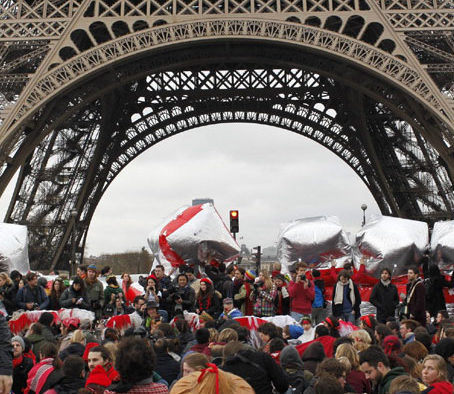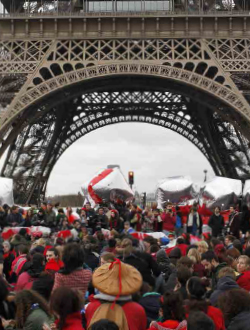“The chief consequence of the Paris deal…

Lindsay Iversen
…is that, for the first time, nearly all of the world’s nations have committed to take steps to reduce their impact on the climate. For the UN climate process – normally so hamstrung by seemingly irreconcilable differences between developed and developing countries – this is a major achievement. But some of the wilder claims about the Paris deal – for instance, that it guarantees the imminent demise of fossil fuels or grants a reprieve to the world’s coral reefs – are overstated. It is a vital step forward but it is not, alas, a miracle.
The Paris deal has already saved one endangered species: the UN climate regime itself. The failure of the Copenhagen summit in 2009 dangerously undercut public and political faith in the UN’s ability to deliver a global deal. Another acrimonious collapse could well have doomed the UN climate enterprise, dealing a serious blow to humanity’s bid to slow climate change. The UN process is the only vehicle in existence for motivating broad, multinational action on this issue. No other forum combines the moral authority of the drowning small island states, the global political visibility to create public pressure, and the participation of enough major emitters to create a meaningful deal. As Winston Churchill might have said were he here, the UN negotiations are the worst climate process that we have, except for all the others. So it is important that it survived.
As Winston Churchill might have said were he here, the UN negotiations are the worst climate process that we have, except for all the others. So it is important that it survived.
Institutions are one thing; results are another. All international agreements depend on implementation at the national level to achieve their aims, and the Paris deal is no exception. The coming years could see states fail to fulfill the pledges that they made to reduce or limit their carbon emissions. Thankfully, negotiators anticipated that possibility. The Paris framework establishes transparency rules so that international observers can determine whether countries are on track to meet their pledges, and hold them to public account if they are not. Moreover, the framework commits parties to regular reviews of their emissions reduction promises and a process through which they can be ‘ratcheted up’ over time. These rules will create the context within which countries will make climate and energy decisions for decades to come.
All of this talk of ratchet mechanisms and transparency rules can make the Paris agreement sound like a boring slog of regulatory compliance. In truth, however, it is much more than that. It creates a real opportunity for states to work together, under a single framework, to mitigate climate change. Opportunities, though, are what people make of them. The work of reaching this agreement was monumental. The work of implementing it has only begun.”
» Lindsay Iversen is the Associate Director for Climate and Resources in the Maurice R. Greenberg Center for Geoeconomic Studies at the US Council on Foreign Relations.
Kishore Mahbubani
…will be a better world for the seven billion people on our planet. The reason for which Paris succeeded and Copenhagen failed is that the major developing countries – especially China and India – agreed to take on more than their fair share of responsibilities in dealing with global warming. Both Beijing and New Delhi agreed to new limits on their greenhouse gas emissions.
This was a remarkably generous gesture on the part of China and India because, as I explained in The New Asian Hemisphere, climate change is not happening simply on account of the new ‘flows’ of greenhouse gases from these two huge countries. It is also the result of the ‘stock’ of greenhouse gases that Western industrialized countries have put into the atmosphere since the Western Industrial Revolution. In any equitable solution, then, the richer Western countries should pay an economic price for this ‘stock’ to match the economic price that China and India are paying to limit their new ‘flows.’
Alas, Western populations are reluctant to accept their fair share of responsibility in dealing with climate change. This is why the world should be grateful that the developing countries, despite this failure, have agreed to bear some of the global burden in limiting greenhouse gas emissions. This gives some hope that global warming may be restrained.”
» Kishore Mahbubani is Dean of the Lee Kuan Yew School of Public Policy, National University of Singapore. His latest book is The Great Convergence: Asia, the West and the Logic of One World.
Sergey Bobylev
…is clear Russian positioning on the question of climate change. In spite of continuous scientific, political and civil society discussion in Russia in respect of the generally weak scientific basis for explaining the problem of global climate change, President Putin has recognized the problem as a serious challenge for humanity, with clear consequences for the future of Russia. He confirmed this position in his remarks in Paris.
Russia overpaid its obligations on the Kyoto Accord, having significantly reduced its greenhouse gas emissions since 1990. Of course, this happened largely as a result of the massive shrinking of the national economy in the 1990s after the collapse of the USSR. By the year 2030, Russia envisages decreasing greenhouse gas emissions to 70 percent of the 1990 levels. This is not an unrealistic commitment given the projected slowdown in Russia’s economic growth.”
» Sergey Bobylev is Professor of Environmental Economics at Moscow State University.
Roger-Mark De Souza
…must be that, at last, all developed and developing nations are required to take action to tackle global warming by limiting their greenhouse gas emissions. Governments are to hold the rise in average global temperatures to “well below” two degrees Celsius compared to pre-industrial levels, and to subsequently work on limiting the increase to 1.5 degrees. The 1.5 degree target is a win for small islands and other low-lying countries, which say that their lands and livelihoods are at risk if the world warms by more than this target. The agreement requires action for the first time from developing nations, including large emitters such as China and India, to find ways to lower the trajectory of their emissions growth.
The new climate agreement is a universal, legal agreement under the UN Framework Convention on Climate Change (UNFCCC), the international convention on climate change that came into force in 1994. More than 190 countries approved the Paris climate agreement, which will be open for signature in April 2016, and come into force in January 2020. The agreement made significant progress on the three main pillars of climate change policy (mitigation, adaptation, and loss and damage) and, significantly, welcomed to the negotiation table key players that had been missing in action, such as China and Canada.
Under the terms of the deal, every five years, each country will submit a new national climate action plan, which cannot be less ambitious than the previous plan. The five-year review will be accompanied by a reporting and transparency system.
On the adaptation front, the agreement establishes a goal to enhance adaptive capacity, strengthen resilience, and reduce vulnerability to negative climate change impacts. Beyond adaptation, the agreement specifically makes reference to “loss and damage” due to climate-related disasters – referring to either what could be repaired, such as critical infrastructure, or to what is lost forever due to climate change, such as ancestral lands submerged under rising seas. While a footnote in the agreement clearly states that loss and damage do not involve liability or compensation, the agreement makes permanent the Warsaw International Mechanism on Loss and Damage, established two years ago in order to find ways to address these issues.
Despite the accomplishments of COP 21, financing for climate change remains a challenge. With the Paris agreement, there is a commitment by the wealthier nations to provide US$100 billion per year toward climate adaptation in support of poorer nations. But it is not yet certain how firm this commitment is, and how quickly the money will flow.”
» Roger-Mark De Souza is the Director of Population, Environmental Security and Resilience at the Woodrow Wilson Center in Washington, DC.










